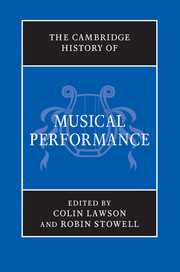Book contents
- Frontmatter
- PART I PERFORMANCE THROUGH HISTORY
- PART II PRE-RENAISSANCE PERFORMANCE
- 7 The Ancient World
- 8 Performance before c. 1430: an overview
- 9 Vocal performance before c. 1430
- 10 Instrumental performance before c. 1430
- 11 Case study: Guillaume de Machaut, ballade 34, ‘Quant Theseus / Ne quier veoir’
- PART III PERFORMANCE IN THE RENAISSANCE (C. 1430–1600)
- PART IV PERFORMANCE IN THE SEVENTEENTH CENTURY
- PART V PERFORMANCE IN THE ‘LONG EIGHTEENTH CENTURY’
- PART VI PERFORMANCE IN THE NINETEENTH CENTURY
- PART VII THE TWENTIETH CENTURY AND BEYOND
- PART VIII
- Index
9 - Vocal performance before c. 1430
from PART II - PRE-RENAISSANCE PERFORMANCE
Published online by Cambridge University Press: 28 March 2012
- Frontmatter
- PART I PERFORMANCE THROUGH HISTORY
- PART II PRE-RENAISSANCE PERFORMANCE
- 7 The Ancient World
- 8 Performance before c. 1430: an overview
- 9 Vocal performance before c. 1430
- 10 Instrumental performance before c. 1430
- 11 Case study: Guillaume de Machaut, ballade 34, ‘Quant Theseus / Ne quier veoir’
- PART III PERFORMANCE IN THE RENAISSANCE (C. 1430–1600)
- PART IV PERFORMANCE IN THE SEVENTEENTH CENTURY
- PART V PERFORMANCE IN THE ‘LONG EIGHTEENTH CENTURY’
- PART VI PERFORMANCE IN THE NINETEENTH CENTURY
- PART VII THE TWENTIETH CENTURY AND BEYOND
- PART VIII
- Index
Summary
Introduction
Do not force the high notes. Sing sweetly, elegantly, and with fluidity – neither harshly nor nasally. Be rhythmically flexible where appropriate. Tune chords from the lowest voice upwards. Avoid singing wrong notes, respect natural word stress, and make the text clearly audible. Ensure that the members of an ensemble can see each other, and encourage them to follow the hand gestures of their musical director.
The interpretation of medieval Latin treatises is fraught with difficulty, but above is a distillation of some of the clearer instructions contained within surviving sources relating to the vocal performance of the music of the European Middle Ages. The term ‘Middle’ Ages is a loaded one: in popular parlance it can imply a low ebb in European civilisation between the sophistication of Classical Antiquity and the enlightenment of the modern era. Indeed the first two-thirds of the Middle Ages used to be labelled the Dark Ages – nowadays more positively designated Late Antiquity. It was only with the emergence of the Gothic style and the creation of universities that Europe was deemed (in nineteenth-century terms) to have rehoisted itself out of the cultural primeval soup: ‘in the time when the wisdom of the ancient times was dead and had passed away, and our own days of light had not yet come, there lay a great black gulf in human history, a gulf of ignorance, of superstition, of cruelty, and of wickedness’. Yet these erstwhile Dark Ages witnessed – alongside many other great achievements – the composition and codification of a great body of monophonic sacred music (plainchant) and the cultivation of the earliest polyphony (organum).
- Type
- Chapter
- Information
- The Cambridge History of Musical Performance , pp. 248 - 260Publisher: Cambridge University PressPrint publication year: 2012

